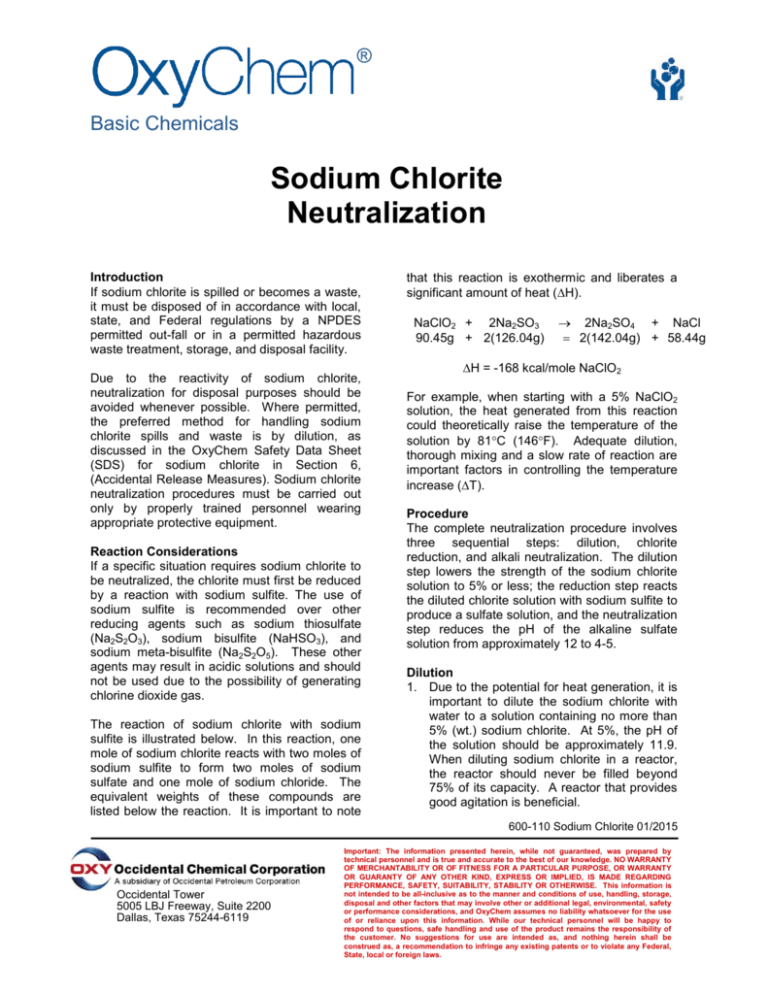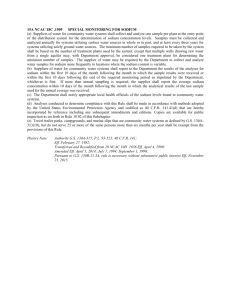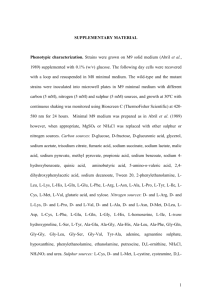Sodium Chlorite Neutralization
advertisement

® Basic Chemicals Sodium Chlorite Neutralization Introduction If sodium chlorite is spilled or becomes a waste, it must be disposed of in accordance with local, state, and Federal regulations by a NPDES permitted out-fall or in a permitted hazardous waste treatment, storage, and disposal facility. Due to the reactivity of sodium chlorite, neutralization for disposal purposes should be avoided whenever possible. Where permitted, the preferred method for handling sodium chlorite spills and waste is by dilution, as discussed in the OxyChem Safety Data Sheet (SDS) for sodium chlorite in Section 6, (Accidental Release Measures). Sodium chlorite neutralization procedures must be carried out only by properly trained personnel wearing appropriate protective equipment. Reaction Considerations If a specific situation requires sodium chlorite to be neutralized, the chlorite must first be reduced by a reaction with sodium sulfite. The use of sodium sulfite is recommended over other reducing agents such as sodium thiosulfate (Na2S2O3), sodium bisulfite (NaHSO3), and sodium meta-bisulfite (Na2S2O5). These other agents may result in acidic solutions and should not be used due to the possibility of generating chlorine dioxide gas. The reaction of sodium chlorite with sodium sulfite is illustrated below. In this reaction, one mole of sodium chlorite reacts with two moles of sodium sulfite to form two moles of sodium sulfate and one mole of sodium chloride. The equivalent weights of these compounds are listed below the reaction. It is important to note that this reaction is exothermic and liberates a significant amount of heat (H). NaClO2 + 2Na2SO3 90.45g + 2(126.04g) 2Na2SO4 + NaCl 2(142.04g) + 58.44g H = -168 kcal/mole NaClO2 For example, when starting with a 5% NaClO2 solution, the heat generated from this reaction could theoretically raise the temperature of the solution by 81C (146F). Adequate dilution, thorough mixing and a slow rate of reaction are important factors in controlling the temperature increase (T). Procedure The complete neutralization procedure involves three sequential steps: dilution, chlorite reduction, and alkali neutralization. The dilution step lowers the strength of the sodium chlorite solution to 5% or less; the reduction step reacts the diluted chlorite solution with sodium sulfite to produce a sulfate solution, and the neutralization step reduces the pH of the alkaline sulfate solution from approximately 12 to 4-5. Dilution 1. Due to the potential for heat generation, it is important to dilute the sodium chlorite with water to a solution containing no more than 5% (wt.) sodium chlorite. At 5%, the pH of the solution should be approximately 11.9. When diluting sodium chlorite in a reactor, the reactor should never be filled beyond 75% of its capacity. A reactor that provides good agitation is beneficial. 600-110 Sodium Chlorite 01/2015 Occidental Tower 5005 LBJ Freeway, Suite 2200 Dallas, Texas 75244-6119 Important: The information presented herein, while not guaranteed, was prepared by technical personnel and is true and accurate to the best of our knowledge. NO WARRANTY OF MERCHANTABILITY OR OF FITNESS FOR A PARTICULAR PURPOSE, OR WARRANTY OR GUARANTY OF ANY OTHER KIND, EXPRESS OR IMPLIED, IS MADE REGARDING PERFORMANCE, SAFETY, SUITABILITY, STABILITY OR OTHERWISE. This information is not intended to be all-inclusive as to the manner and conditions of use, handling, storage, disposal and other factors that may involve other or additional legal, environmental, safety or performance considerations, and OxyChem assumes no liability whatsoever for the use of or reliance upon this information. While our technical personnel will be happy to respond to questions, safe handling and use of the product remains the responsibility of the customer. No suggestions for use are intended as, and nothing herein shall be construed as, a recommendation to infringe any existing patents or to violate any Federal, State, local or foreign laws. ® Basic Chemicals Chlorite Reduction 2. Slowly and carefully, add dry sodium sulfite at a ratio of 2.8 lbs. of dry sodium sulfite per pound of active sodium chlorite in the solution and mix thoroughly. For a diluted (5%) sodium chlorite solution, this is equivalent to 1.2 lbs. (548 grams) of dry sodium sulfite per gallon of solution (197 grams of active sodium chlorite). The addition of an excess of sodium sulfite will assure the complete reduction of chlorite, and will prevent the generation of chlorine dioxide in the next step. As a precaution, sodium sulfite should be added slowly to allow for adequate heat dissipation. Thorough mixing of the sodium sulfite is very important to prevent the generation of chlorine dioxide during the addition of hydrochloric acid in step 3. Alkali Neutralization 3. Once the chlorite has been completely reacted, slowly add a 5% hydrochloric acid (HCl) solution to lower the pH to 4-5, and mix thoroughly to complete the neutralization. HCl should be added at a ratio of 1 gallon of 5% HCl per 10 gallons of reduced 5% sodium chlorite from step 2. Monitor and maintain the solution temperature below 100F. Rapid additions of acid will cause excessive temperature increases. Additions of HCl in excess of the 1/10 ratio will contribute to corrosion problems and safety concerns. dioxide gas is liberated during the addition of sodium bicarbonate to acid. Appropriate safety precautions may need to be taken if a significant quantity of carbon dioxide gas is generated. Verify Neutralization is Complete 5. Sample the neutralized product in a clear beaker or equivalent. Maintain a pH of 4-5, monitoring with acid/base pH paper. As a final indicator, test the solution with KI/starch indicator paper. Neutralization is complete when the paper does not turn black, blue, or brown in color. 6. If the paper turns black, blue, or brown, neutralization is not complete and chlorine dioxide could be generated. Add additional sodium sulfite, mix, and repeat steps 4, 5 and 6. 7. Dispose of the neutralized material in accordance with local, state, and Federal regulations. Further Information More detailed information on sodium chlorite is available upon request through the OxyChem Technical Service Department. Call or write to: Technical Service Department OxyChem Post Office Box 12283 Wichita, Kansas 67277-2283 800-733-1165 option #1 www.oxy.com The use of stronger acid concentrations can result in the generation of extreme heat and material splattering and should be avoided. 4. Monitor and maintain the pH of the solution between 4-5. Use acid/base pH test paper with a range of pH 2-10. If too much acid is added, sodium bicarbonate (common baking soda) can be used to raise the pH. Carbon 600-110 Sodium Chlorite 01/2015 Occidental Tower 5005 LBJ Freeway, Suite 2200 Dallas, Texas 75244-6119 Important: The information presented herein, while not guaranteed, was prepared by technical personnel and is true and accurate to the best of our knowledge. NO WARRANTY OF MERCHANTABILITY OR OF FITNESS FOR A PARTICULAR PURPOSE, OR WARRANTY OR GUARANTY OF ANY OTHER KIND, EXPRESS OR IMPLIED, IS MADE REGARDING PERFORMANCE, SAFETY, SUITABILITY, STABILITY OR OTHERWISE. This information is not intended to be all-inclusive as to the manner and conditions of use, handling, storage, disposal and other factors that may involve other or additional legal, environmental, safety or performance considerations, and OxyChem assumes no liability whatsoever for the use of or reliance upon this information. While our technical personnel will be happy to respond to questions, safe handling and use of the product remains the responsibility of the customer. No suggestions for use are intended as, and nothing herein shall be construed as, a recommendation to infringe any existing patents or to violate any Federal, State, local or foreign laws.






